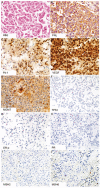Temozolomide Nonresponsiveness in Aggressive Prolactinomas and Carcinomas: Management and Outcomes
- PMID: 35059545
- PMCID: PMC8763612
- DOI: 10.1210/jendso/bvab190
Temozolomide Nonresponsiveness in Aggressive Prolactinomas and Carcinomas: Management and Outcomes
Abstract
Context: Temozolomide (TMZ) is endorsed as the treatment of choice in aggressive or malignant pituitary adenomas.
Objective: Herein we describe a case of an aggressive prolactinoma that was resistant to TMZ. We performed a literature review of similar nonresponsive, aggressive prolactinomas.
Methods: A 40-year-old woman presented with a giant prolactinoma that required cabergoline, transsphenoidal surgery, and radiotherapy to achieve near-normal prolactin and apparently no residual tumor. A year later, she presented with multiple cranial nerve involvement due to a recurrent tumor extending to the infratemporal fossa. She underwent transfrontal surgery, second radiotherapy, and was started on TMZ. Despite 8 cycles of temozolomide (200 mg/m2, 5/28-day cycle), she had progressive disease and ultimately succumbed to the disease. PubMed/MEDLINE, Google Scholar, and prior review articles were searched for manuscripts about patients with aggressive prolactinomas who had been treated with TMZ. Data on demography, duration of therapy, and management outcomes were analyzed in those with progressive disease.
Results: We identified 94 cases of patients with aggressive/malignant prolactinomas in the literature who had received TMZ. Progressive disease despite TMZ was present in 36 cases (38%). There was a male preponderance (65%) among these and 40% had aggressive prolactinomas, whereas the rest had carcinomas. Patients received a median of 8 cycles (interquartile range, 3.5-11.5) of TMZ. O6-methylguanine-DNA-methyltransferase (MGMT) immunostaining was negative in 35%. Overall mortality at the time of publication was 40%, at a duration varying from 2 to 20 years from diagnosis.
Conclusion: TMZ resistance in aggressive/malignant prolactinomas is challenging. Progressive disease on optimal TMZ treatment entails the use of newer agents.
Keywords: MGMT; aggressive prolactinoma; temozolomide; temozolomide resistance.
© The Author(s) 2021. Published by Oxford University Press on behalf of the Endocrine Society.
Figures





References
-
- Raverot G, Burman P, McCormack A, et al. ; European Society of Endocrinology. European Society of Endocrinology clinical practice guidelines for the management of aggressive pituitary tumours and carcinomas. Eur J Endocrinol. 2018;178(1):G1-G24. - PubMed
-
- McCormack A, Dekkers OM, Petersenn S, et al. ; ESE survey collaborators. Treatment of aggressive pituitary tumours and carcinomas: results of a European Society of Endocrinology (ESE) survey 2016. Eur J Endocrinol. 2018;178(3):265-276. - PubMed
-
- Trouillas J, Delgrange E, Wierinckx A, et al. . Clinical, pathological, and molecular factors of aggressiveness in lactotroph tumours. Neuroendocrinology. 2019;109(1):70-76. - PubMed
-
- Dworakowska D, Grossman AB. Aggressive and malignant pituitary tumours: state-of-the-art. Endocr Relat Cancer. 2018;25(11):R559-R575. - PubMed
-
- Gillam MP, Molitch ME, Lombardi G, Colao A. Advances in the treatment of prolactinomas. Endocr Rev. 2006;27(5):485-534. - PubMed
Publication types
Grants and funding
LinkOut - more resources
Full Text Sources
Research Materials
